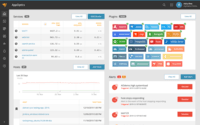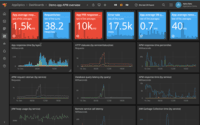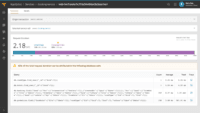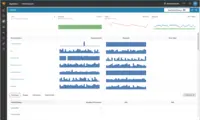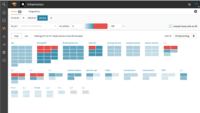Overview
What is SolarWinds AppOptics?
SolarWinds AppOptics (formerly Librato) is an IT infrastructure monitoring service and APM, based on technology acquired by SolarWinds with Librato in 2015 to expand its cloud monitoring portfolio.
AppOptics+loggly is cost-effective.
AppOptics: A must-have for a startup
Master Player just Born
A Great Product for an Affordable Price.
AppOptics - Monitoring tool for emerging organisations.
Review!
How AppOtics make our life easier
Cost-effective, easy to use and sufficiently detailed APM
The best-priced performance APM solution in our industry
SolarWinds AppOptics is a Breeze
AppOptics - Effective Application Performance Monitoring Tool
Very Happy
Fast and simple way to see application performance
Its good and easy to use
Monitoring is Now More Easy
Awards
Products that are considered exceptional by their customers based on a variety of criteria win TrustRadius awards. Learn more about the types of TrustRadius awards to make the best purchase decision. More about TrustRadius Awards
Popular Features
- Application monitoring (30)8.585%
- Database monitoring (28)7.575%
- Application performance management console (26)7.070%
- Threshold alerts (26)6.363%
Pricing
What is SolarWinds AppOptics?
SolarWinds AppOptics (formerly Librato) is an IT infrastructure monitoring service and APM, based on technology acquired by SolarWinds with Librato in 2015 to expand its cloud monitoring portfolio.
Entry-level set up fee?
- No setup fee
Offerings
- Free Trial
- Free/Freemium Version
- Premium Consulting/Integration Services
Would you like us to let the vendor know that you want pricing?
2 people also want pricing
Alternatives Pricing
What is IBM Instana?
Instana, an IBM company since the December 2020 acquisition, provides APM services for SOA, microservices, containerized applications and Kubernetes, and cloud native applications, as well as discovery and monitoring for IT assets.
What is ScienceLogic SL1?
ScienceLogic is a system and application monitoring and performance management platform. ScienceLogic collects and aggregates data across and IT ecosystems and contextualizes it for actionable insights with the SL1 product offering.
Features
Application Performance Management
Application performance management software monitors software to ensure performance and availability
- 8.5Application monitoring(30) Ratings
Application monitoring involves tracking response times and resource usage for applications, including highly-distributed applications
- 7.5Database monitoring(28) Ratings
Database monitoring means looking for database bottlenecks liable to slow response times
- 6.3Threshold alerts(26) Ratings
Alerts indicating when critical thresholds have been reached
- 4.6Predictive capabilities(12) Ratings
Data mining of log and other performance data to understand predictors of slowdowns or outages
- 7Application performance management console(26) Ratings
The management console is used to manage monitoring agents and et thresholds, etc.
- 5.8Collaboration tools(14) Ratings
Collaboration tools enable DevOps staff to collaborate by adding notes/comments and also integrating with external collaboration tools like ticketing systems
- 5.8Out-of-the box templates to monitor applications(20) Ratings
Built-in templates for specific applications
- 6.4Application dependency mapping and thresholding(18) Ratings
Mapping relationships between the application and its underlying infrastructure
- 7.3Virtualization monitoring(13) Ratings
Allows for monitoring of virtual applications and servers
- 8.1Server availability and performance monitoring(23) Ratings
Ability to monitor server availability
- 7.3Server usage monitoring and capacity forecasting(16) Ratings
Ability to assess server usage and forecast future needs
- 6.8IT Asset Discovery(9) Ratings
Discovery of hardware and software assets on the network
Product Details
- About
- Integrations
- Competitors
- Tech Details
- Downloadables
- FAQs
What is SolarWinds AppOptics?
SolarWinds® AppOptics™ is presented by the vendor as a SaaS-based simple, powerful and affordable Infrastructure & Application monitoring for custom on-premises, cloud, and hybrid systems.
Full-stack visibility – Monitor the health and performance of custom on-premises and highly distributed cloud applications across services, hosts, containers, and platforms down to the code.
Reduce MTTR – Monitoring infrastructure and application metrics side-by-side reduces the time it takes to identify what part of the stack is failing, so you can quickly get to the root cause.
Auto-instrumented Root Cause – Quickly pinpoint issues; Automatically presents the most likely cause of a performance problem. Takes the guesswork out of troubleshooting.
Simple Setup – Up and running in minutes, easy to use and a minimal learning curve for IT professionals.
Integration that matters– Cohesive end to end monitoring that enables maximum observability from metrics, to traces, and down to logs.
Align your performance goals with business goals – Incorporate custom metrics to combine business metrics side-by-side with system metrics. See and measure the impact infrastructure and application performance has on your business performance.
Highly scalable – Cost-effectively scale as your business scales with analytics and trend reporting, providing you with insights into short- and long-term changes to performance and resource utilization.
SolarWinds AppOptics Screenshots
SolarWinds AppOptics Video
SolarWinds AppOptics Integrations
SolarWinds AppOptics Competitors
SolarWinds AppOptics Technical Details
| Deployment Types | Software as a Service (SaaS), Cloud, or Web-Based |
|---|---|
| Operating Systems | Unspecified |
| Mobile Application | No |
| Supported Languages | .Net, Go, Java, PHP, Python, Scala, Node |
SolarWinds AppOptics Downloadables
Frequently Asked Questions
Comparisons
Compare with
Reviews and Ratings
(57)Attribute Ratings
Reviews
(1-25 of 30)AppOptics+loggly is cost-effective.
- easy to set up with AWS.
- UI design is straight forward , make it easy to get up to speed.
- price is good compare to others (for small to mid-size infra needs).
- integration with other tools.
- pricing structure should be more flexible.
AppOptics: A must-have for a startup
- Request tracing with code profiling.
- Automated alerting on latency and response codes for each API.
- Low resource overhead while collecting data from our application servers.
- Highly performant dashboard that enables us to make progress rapidly.
- Very resilient. We have not seen a downtime in their service in the entire year that we have used them.
- Identify database and cache requests that are taking longer than expected
- Monitoring and alerting for downstream services can be improved significantly.
- They can make it easier and faster to setup alerts for the infrastructure and application.
Master Player just Born
- Cloud Service Monitoring
- New Technologies Monitoring such as Containers Docker
- APM
- GCP is not Supported
- Oracle is not Supported
- No Integration available with Service Now
A Great Product for an Affordable Price.
- Identifies errors experienced by our end users.
- Locates application errors.
- Provides insight into our end users' overall application experience.
- Allows us to know that our application performance monitoring solutions is in good hands.
- Not applicable.
- SolarWinds AppOptics is a solid, affordable product on par with other APMs I've used in the past.
AppOptics - Monitoring tool for emerging organisations.
- Application Monitoring.
- API monitoring.
- Bifurcation of time consumed for result.
- Remote calls monitoring.
- Database query monitoring.
- Dashboard.
- Ease of use.
- Missing parameters at times.
Review!
- Interactive graph
- None
How AppOtics make our life easier
- Monitoring services.
- Detect service failures.
- Helps pinpoint problems in our website.
- The only thing that I would add is the possibility to display every single query our servers receive to eventually analyze them and query through them. We could also generate nice visualizations from that. Right now I believe we can only see averages.
Cost-effective, easy to use and sufficiently detailed APM
- Compares performance to previous day/week.
- Shows detail of traced requests including DB queries and cache calls.
- Performs quickly and has little lag time between reported detail.
- Report filtering could be more powerful.
- Date comparison options like 4 weeks ago instead of 1 month.
- SolarWinds AppOptics has an easy to use and fast interface. Thus, you can use time more efficiently.
- SolarWinds AppOptics has as many details as you want. So you only display deep details when you want.
- SolarWinds AppOptics already has many plugins. So you can easily connect with your other services.
- The number of plugins should be increased.
- The number of warning methods should be increased.
SolarWinds AppOptics is a Breeze
- The time frame options help track peak hours and compare impact of improvements.
- The detailed breakdown of traces requests helps track down the source of slowness in applications.
- The database queries tracked help find most used tables and help decide where indexing is needed.
- The exceptions graph on the overview screen can be misleading as not all exceptions are high priority.
- Could use more customization on the overview screen. Would like to change what graphs are shown for each service.
- Application Performance Monitoring.
- DB Monitoring.
- Network Monitoring.
- API level check.
- Running application box stats.
- Consumed memory stats.
Very Happy
- Shows each layer of application.
- Code tracing.
- Easy to visualize where the issues are.
- Aggregate info to show problems
- Show layer by layer overview of where time is spent
- Might be related to our setup but correlating info between different apps is not possible.
Its good and easy to use
- Best GUI.
- Detailed view of latencies.
- Application integration is easy.
Monitoring is Now More Easy
- Easy to integrate with an application stack. Supports many. In my case, I just need the AppOptics client and client key to start integration with my application stack.
- Provide real-time metrics like DB connection, query analysis, latency in API calls and other connections, response codes for various API's, etc.
- We can also set thresholds based on use-cases and set up the alerts and publish one across various suitable channels.
- It would be good if could get some sort of dynamic report generation functionality base on historical trends. The rest is good.
1) Current response code from the API.
2) Number of DB connections.
3) Queries requested from app to DB.
4) Queries that track latency.
5) Failing APIs.
AppOptics Review
- Markers: Drill down into specific logical blocks of the execution timeline.
- Remote services: Possibility to track external API calls separately from the main stack.
- Alerting: Possibility to receive alerts as soon as a certain threshold was reached.
- Get to the errors from the dashboard graphs.
- Custom-selected Nth percentile.
- Auto-refresh option for close to live-monitoring.
Detect bottlenecks in your application
- Average response time.
- Average request rate.
- Tracing different layers in a request.
- Detection of slow queries.
- More data can be added, however, it could also be that we haven't set it up fully.
Use SolarWinds AppOptics to see what you don't.
- Compact monitoring
- Tracking of transactions, requests, etc.
- Its simplicity of usage. Less is more.
- Its SMS gateway for notification, so we don't need to use a third party.
- On Infrastructure page, select multiple choices and see Host details for all of them
- Better organization of metrics
Good value for cloud infrastructure monitoring!
- Simple installation and configuration
- Easy to use UI
- Good value
- Many integrations with third-party software
- Better cluster support: identify and group all related hosts automatically based on name
SolarWinds AppOptics: Must-try application
- Provides default dashboards for all your services and we can create custom dashboards as well
- We can configure alerts on API response times and can configure multiple notification channels
- It tracks everything including infrastructure, database response, communication between different micro-services
- Sometimes I have faced issues while creating custom dashboards
- A few metrics do not provide accurate results
- Documentation can be improved
Great tool for application monitoring
- Full application stack trace
- Measuring latency
- Providing historical map of calls
- It's confusing sometimes to dig into a trace, like certain levels don't have much info. AppOptics just says this level occupies 95% of the call time.
- It would be nice to have AppOptics identify if the root cause of an issue was caused by a dependency, e.g. another service it calls. It would be great to chain them together.
- Not very intuitive, if you don't know what you're doing or know what to look for.
Works okay for Python but needs work
- Distributed tracing.
- Basic hardware monitoring.
- Application transaction stats/details.
- Support for celery in Python.
- Overall better Python support.
- Backwards compatibility.
SolarWinds AppOptics Review
As our infra is very huge so we haven't implemented it in the whole organization. But still, we are using it for most of the critical services. Pinpointing the issues becomes very easy during production downtimes.
- Alerting
- Trace debugging
- Remote calls detection
- flexibility of configuration
- Linked graph of microservices can be included
- Deep insight into the ASP.NET pipeline, allowing drill-down into individual requests.
- Intuitive dashboards with the ability to slice by time give a good overview of real-world endpoint performance.
- Ability to drill into individual queries executed during the lifetime of an IIS request provide excellent intelligence for targeted optimization of SQL bottlenecks.
- Extending visualization into the asp.net processing pipeline would be really helpful - the ability to see which handler/piece of middleware did what, and when would be great.
- The ability to capture parameters for certain SQL queries - possibly based on a filter.
- The ability to describe the relationship between requests and users - so being able to see all requests submitted in a particular session (by cookie, http header value, etc) would be most useful.
- Monitoring infrastructure in production. We also use it to track AWS usage and its APM capabilities.
- Whenever there's an exception or slow performance in production we use AppOptics.
- Drilldown to slow transactions in DB or server-side code.
- General visibility of usage vs. spending on AWS.
- Quick view to usage statistics in AWS, instead of going to CloudWatch (for example, SNS messages).
- Easy to integrate.
- No need to instrument code.
- Full visibility.
- Better python instrumentation.
- Monitoring AWS lambda.


